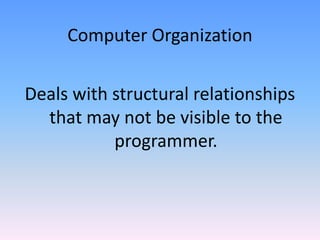Computer organization
•Als PPTX, PDF herunterladen•
0 gefällt mir•1,059 views
Melden
Teilen
Melden
Teilen

Empfohlen
Weitere ähnliche Inhalte
Was ist angesagt?
Was ist angesagt? (20)
Ähnlich wie Computer organization
Ähnlich wie Computer organization (20)
Mca i-fundamental of computer-u-1-computer hardware system

Mca i-fundamental of computer-u-1-computer hardware system
fundamental of computer-u-1-computer hardware system

fundamental of computer-u-1-computer hardware system
Bba i-introduction to computer-u-1-computer hardware system

Bba i-introduction to computer-u-1-computer hardware system
Mehr von Edlynne Ogena
Mehr von Edlynne Ogena (7)
Kürzlich hochgeladen
Enterprise Knowledge’s Urmi Majumder, Principal Data Architecture Consultant, and Fernando Aguilar Islas, Senior Data Science Consultant, presented "Driving Behavioral Change for Information Management through Data-Driven Green Strategy" on March 27, 2024 at Enterprise Data World (EDW) in Orlando, Florida.
In this presentation, Urmi and Fernando discussed a case study describing how the information management division in a large supply chain organization drove user behavior change through awareness of the carbon footprint of their duplicated and near-duplicated content, identified via advanced data analytics. Check out their presentation to gain valuable perspectives on utilizing data-driven strategies to influence positive behavioral shifts and support sustainability initiatives within your organization.
In this session, participants gained answers to the following questions:
- What is a Green Information Management (IM) Strategy, and why should you have one?
- How can Artificial Intelligence (AI) and Machine Learning (ML) support your Green IM Strategy through content deduplication?
- How can an organization use insights into their data to influence employee behavior for IM?
- How can you reap additional benefits from content reduction that go beyond Green IM?
Driving Behavioral Change for Information Management through Data-Driven Gree...

Driving Behavioral Change for Information Management through Data-Driven Gree...Enterprise Knowledge
Kürzlich hochgeladen (20)
Driving Behavioral Change for Information Management through Data-Driven Gree...

Driving Behavioral Change for Information Management through Data-Driven Gree...
How to Troubleshoot Apps for the Modern Connected Worker

How to Troubleshoot Apps for the Modern Connected Worker
[2024]Digital Global Overview Report 2024 Meltwater.pdf![[2024]Digital Global Overview Report 2024 Meltwater.pdf](data:image/gif;base64,R0lGODlhAQABAIAAAAAAAP///yH5BAEAAAAALAAAAAABAAEAAAIBRAA7)
![[2024]Digital Global Overview Report 2024 Meltwater.pdf](data:image/gif;base64,R0lGODlhAQABAIAAAAAAAP///yH5BAEAAAAALAAAAAABAAEAAAIBRAA7)
[2024]Digital Global Overview Report 2024 Meltwater.pdf
The 7 Things I Know About Cyber Security After 25 Years | April 2024

The 7 Things I Know About Cyber Security After 25 Years | April 2024
Tech Trends Report 2024 Future Today Institute.pdf

Tech Trends Report 2024 Future Today Institute.pdf
HTML Injection Attacks: Impact and Mitigation Strategies

HTML Injection Attacks: Impact and Mitigation Strategies
Strategies for Unlocking Knowledge Management in Microsoft 365 in the Copilot...

Strategies for Unlocking Knowledge Management in Microsoft 365 in the Copilot...
Workshop - Best of Both Worlds_ Combine KG and Vector search for enhanced R...

Workshop - Best of Both Worlds_ Combine KG and Vector search for enhanced R...
Apidays New York 2024 - Scaling API-first by Ian Reasor and Radu Cotescu, Adobe

Apidays New York 2024 - Scaling API-first by Ian Reasor and Radu Cotescu, Adobe
Strategize a Smooth Tenant-to-tenant Migration and Copilot Takeoff

Strategize a Smooth Tenant-to-tenant Migration and Copilot Takeoff
Automating Google Workspace (GWS) & more with Apps Script

Automating Google Workspace (GWS) & more with Apps Script
What Are The Drone Anti-jamming Systems Technology?

What Are The Drone Anti-jamming Systems Technology?
TrustArc Webinar - Stay Ahead of US State Data Privacy Law Developments

TrustArc Webinar - Stay Ahead of US State Data Privacy Law Developments
Computer organization
- 1. Computer Organization Deals with structural relationships that may not be visible to the programmer.
- 2. Levels of Computer Organization >Highest Level > Lowest Level
- 3. >Processor-- center for manipulation and control >Memory – storage for instructions and data for currently executing programs >I/O system – controller which communicate with “ external” devices: secondary memory, display devices, networks >Data-path & control – collection of parallel wires, transmits data, instructions, or control signal A stored program computer has the following basic units:
- 5. Wolf Radius Bone • Wolf radius bone ca. 25,000–30,000 B.C. showing 55 cuts in groups of five, suggesting a rudimentary form of multiplication or division.
- 6. Tally Sticks was an ancient memory aid device to record and document numbers, quantities, or even messages.
- 7. Chinese Abacus • Representation of 39,017 on a Chinese abacus.
- 8. Cylinder Music Box • Victorian Swiss cylinder music box, dated 1862.
- 9. Pascal’s Calculating Machine • Performs basic arithmetic operations (early to mid 1600’s). Does • not have what may be considered the basic parts of a computer.
- 10. Babbage’s Difference Engine #1 • Working portion of Babbage’s Difference Engine No. 1, which is • the first known automatic calculator.
- 11. The Jacquard Pattern Weaving Loom • The Jacquard pattern weaving loom
- 12. Enigma • Siemens Halkse T-52 Sturgeon (Enigma) cipher machine.
- 13. Colossus • The Colossus (ca. 1944).
- 14. The ENIAC
- 15. Moore’s Law • Computing power doubles every 18 months, for the same price.
- 16. The von Neumann Model • The von Neumann model consists of five major components: (1) input unit; (2) output unit; (3) arithmetic logic unit; (4)memory unit; (5) control unit.
- 17. BASIC COMPUTER OPERATIONS A computer performs basically five major operations or functions irrespective of their size and make. These are 1) it accepts data or instructions by way of input, 2) it stores data, 3) it can process data as required by the user, 4) it gives results in the form of output, and 5) it controls all operations inside a computer. We discuss below each of these operations.
- 18. 1. Input: This is the process of entering data and programs in to the computer system. 2. Storage: The process of saving data and instructions permanently is known as storage 3. Processing: The task of performing operations like arithmetic and logical operations is called processing. 4. Output: This is the process of producing results from the data for getting useful information. 5. Control: The manner how instructions are executed and the above operations are performed.
- 19. A Typical Computer System
